Returning to her roots
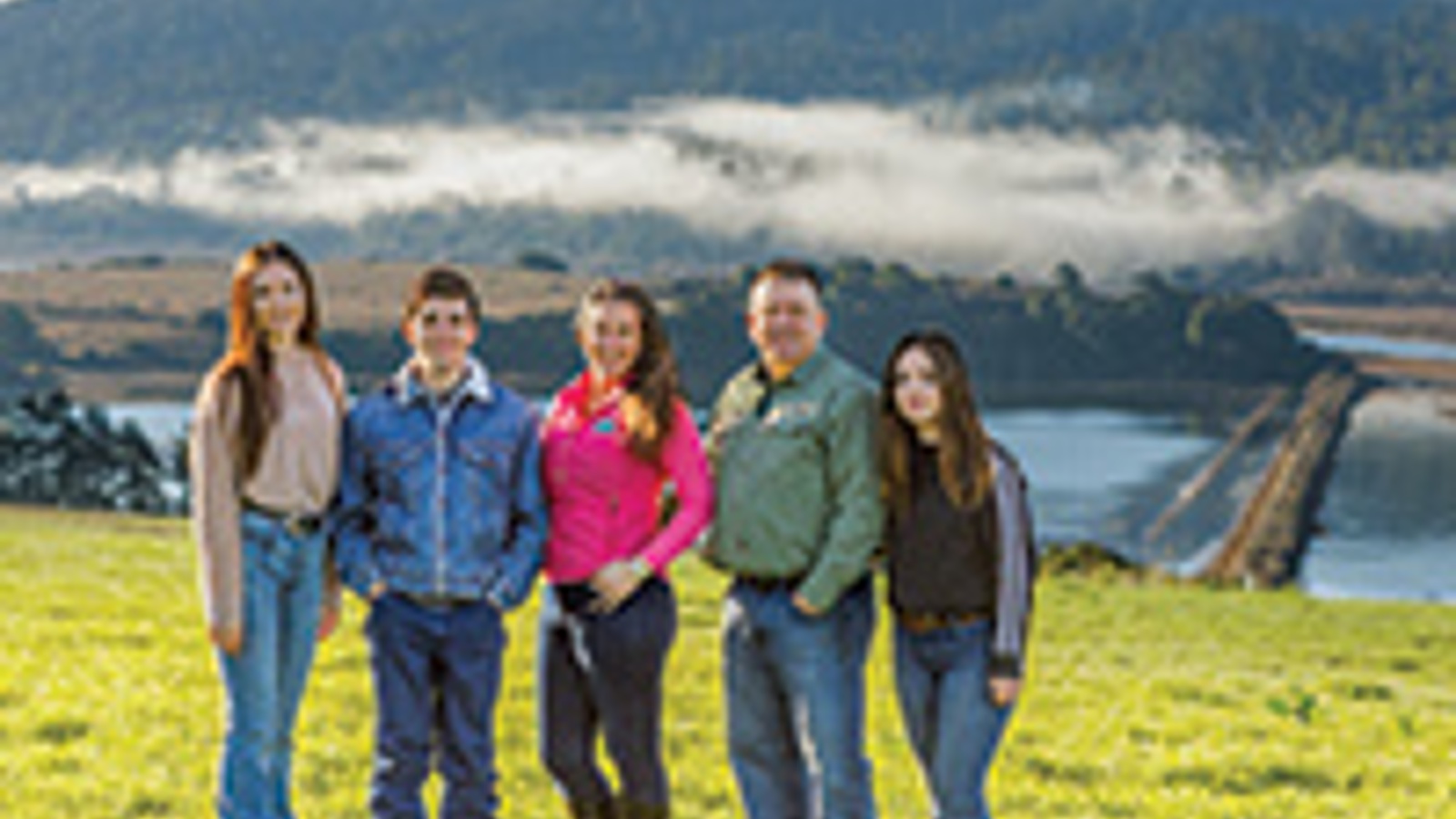
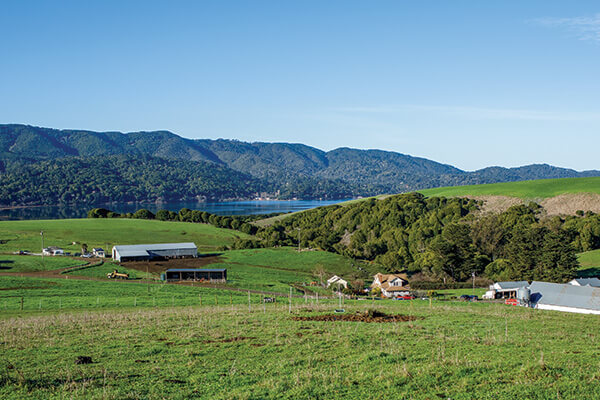
Rolling hills and fog from nearby Tomales Bay support the pasture management and grazing strategies at Bivalve Dairy. Photo: © 2021 Paige Green
Karen and John Taylor didn't set out to be dairy farmers. But in 2006, the couple changed career courses and put down new roots on the west Marin County dairy farm Karen's parents began in 1973—the year she was born—and focused on building the future Bivalve Dairy.
Fifteen years later, the Taylors have transitioned the pasture-based grazing operation and dairy into an organic-certified business, created sustainable farming systems across 1,500 acres of ranch land, established a creamery, raised three children on the ranch, and weathered the pressures of a pandemic, wildfires and extended droughts.
"Our goal is to create a sustainable operation for generations to come," John said.
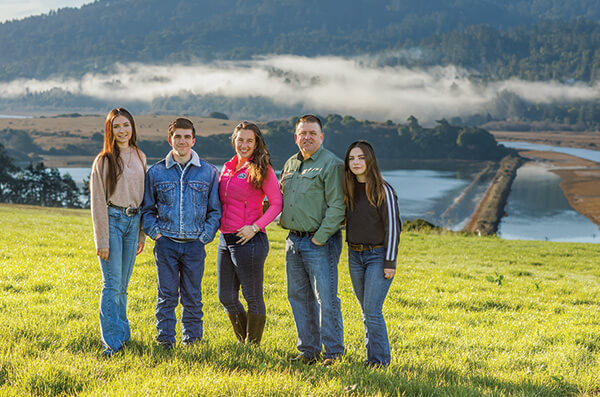
Farmers John and Karen Taylor are raising their children, from left, Camilla, William and Eva, at the ranch. Photo: © 2021 Paige Green
Karen is a sixth-generation dairy farmer, continuing the practices learned while growing up at her parents' ranch overlooking Tomales Bay, an hour from San Francisco and minutes from the rocky headlands of Point Reyes National Seashore. Her family's farming heritage goes back to Portugal's lush Azores islands, where dairy cows have grazed on similarly fog-shrouded pastures for decades.
Karen was a junior high school teacher in the San Francisco Bay Area before returning to the ranch. John was an industrial engineer for General Electric Co. before he and Karen began managing the dairy, named for an old train station located on the ranch site in the early 1900s.
These days, you'll find Karen tending to the couple's herd of 500 Holsteins or selling Bivalve Dairy handcrafted cheeses and cultured butter at local stores and farmers markets. John applies his technology background and "what if" sense of curiosity to develop and manage innovative farming practices used throughout the operation.
"Everything we do is based on technology to ensure quality. It controls all aspects of our business, from pasture to consumer," John said. "As an engineer, my mind is always going."
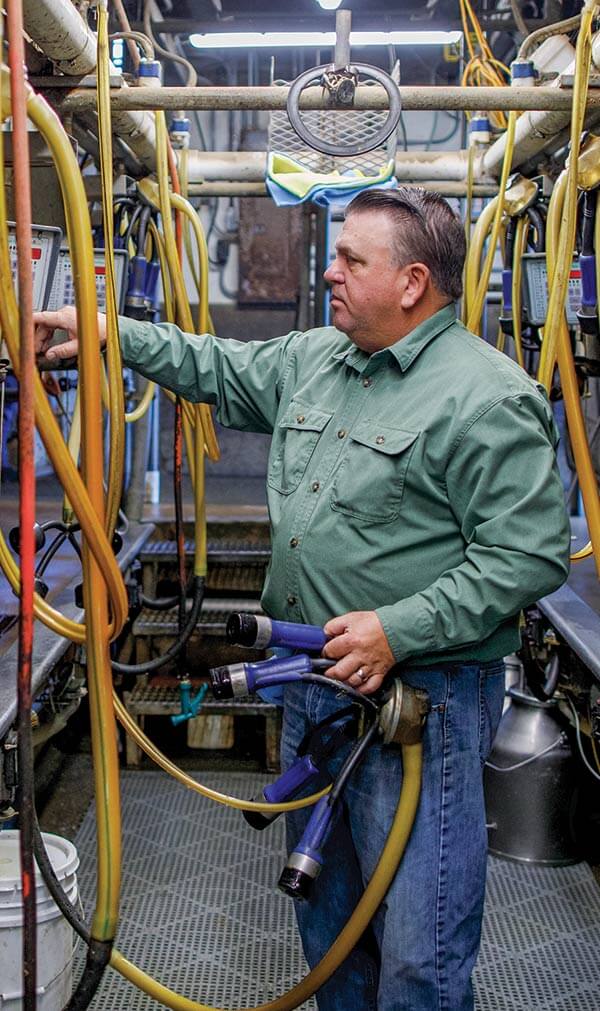
John Taylor applies his technology background throughout the dairy, including the milking barn, where milking begins at 2 a.m. daily. Photo: © 2021 Paige Green
A zero-waste goal
The Taylors' current project is upgrading the dairy's manure management system to reduce water use and greenhouse gas emissions. The new system will convert a current freshwater flush system used to clean the cows' barn and replace it with a scraping system (John compares it to a Roomba-type vacuum cleaner). The conversion includes a new method of creating manure compost that can be applied to the farm's pastures and used as bedding for the animals.
"Our goal is to have zero waste with all that we do," he said.
The couple focused on developing sustainable, organic operations from the start. A year after assuming the dairy, the Taylors completed the steps necessary to transition Bivalve Dairy into a certified organic farm. The process included switching to organic methods of growing feed and caring for the cattle as well as the land. Early on, Bivalve Dairy met the standards to sell milk to Clover Sonoma, an organic dairy company that was the first in the nation to be certified for its animal health and safety practices.
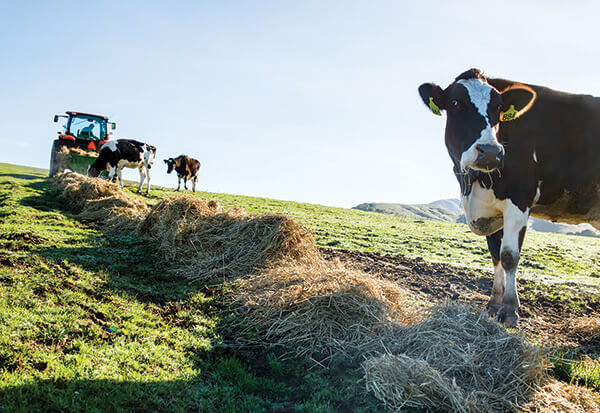
The family cares for about 500 Holstein cattle on their Marin County ranch. Photo: © 2021 Paige Green
Healthy pastures
The Taylors employ pasture management and grazing strategies to benefit the land and the herd, while making the most of the 700 acres where the cows spend much of the year grazing. The region's rolling hills and moderate climate, along with the fog that rolls off Tomales Bay, create exceptional conditions for pasture grazing.
"Grass grows well here," John said. "Grass is the herd's least expensive and most nutritious food source. The pastures are our future, and we take care of them."
Pasture management techniques include sampling soils and creating seed mixes to suit growing conditions. Pastures are aerated to promote water absorption and downward root growth, while no-till seeding helps reduce erosion and hold soil nutrients in place. The farmers employ several methods to produce healthy feed, limit water usage and reduce the farm's carbon footprint.
To sustain the health of the land, the Taylors use a rotational grazing system that moves the cows to new pastures every time they leave the barn. The couple works with a nutritionist to create custom feeds that help the cows efficiently digest the native forages.
"The quality of the pastures, hay and silage on our three ranches helps the cows produce consistent, high-quality milk components, including solids and milk fat," John said.
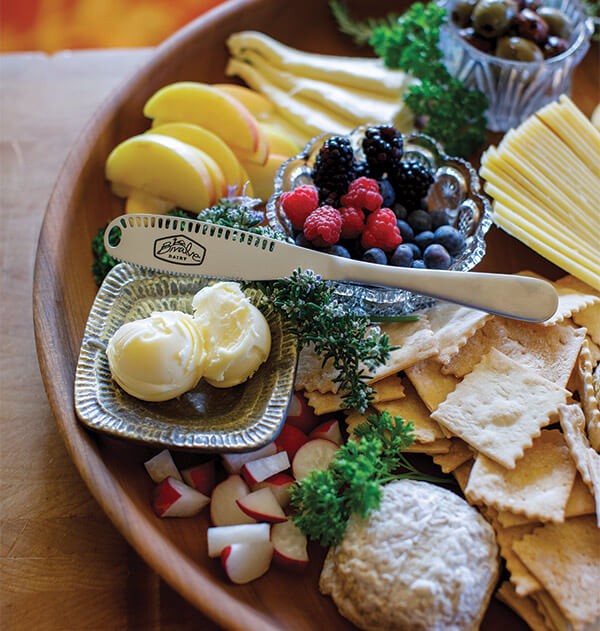
The Taylors supply milk to Cowgirl Creamery and also make their own artisan cheeses and European-style cultured butter. Photo: © 2021 Paige Green
Artisan cheese and butter
Since 2010, Bivalve Dairy has partnered with artisan cheesemakers at nearby Cowgirl Creamery, a producer known for locally produced, pasture-based organic cheeses. Bivalve Dairy supplies raw milk used to make Cowgirl Creamery's popular triple-cream Red Hawk cheese, as well as some of its fresh and seasonal cheeses.
"We caught their attention because our milk components are so consistent. Cheesemakers love that," John said.
"Bivalve Dairy makes some of the most beautifully rich milk," said Amanda Parker, managing director of Cowgirl Creamery. "Ingredients mean everything to the end result of the cheese. Good cheese comes from good milk, which in turn is a product of healthy soils and animals."
In addition to supplying their dairy's milk to Cowgirl Creamery, the Taylors recently began making their own artisan cheeses and European-style butter. Bivalve Dairy makes a total of 11 products in small lots: two types of cultured butter and a number of fresh and aged cheeses with names such as Haystack Jack, Seahaven and Aftershock, as nods to their locale.
When the Taylors entered the artisan cheese world, a consultant told them, "Your milk will tell you what type of cheese to make," referring to the milk's fresh pasture flavors and other natural qualities that are reflected in handmade cheese. The mild temperatures and humidity of their coastal environment also play important roles in defining Bivalve Dairy cheeses.
One Bivalve Dairy cheese—Mendonça—was recently recognized as a national finalist in the Good Food Awards. Its success is especially meaningful to the Taylors, as Mendonça is a Portuguese-style cheese that pays homage to Karen's family name and farming history. The handmade, aged cheese enjoys a fan base in the Portuguese community because it's similar to a traditional Azores island cheese, with its tangy and grassy flavors and piquant finish.
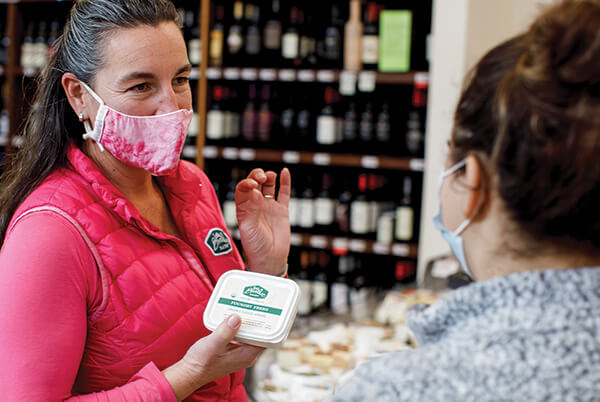
Karen Taylor visits local markets selling Bivalve Dairy products. Photo: © 2021 Paige Green
Pushing through the pandemic
Bivalve Dairy cheeses are sold in markets throughout the Bay Area and at local farmers markets, where Karen and the Taylor family greet customers from their booth.
"It's so humbling to talk with our customers," John said. "While Karen's a true cowgirl, she's also very good at sales because she's so involved in making the product."
Although the pandemic has affected the couple's plans to expand the company's retail sales, their product sales through existing channels and at farmers markets have grown. There is one challenge: not being able to offer samples.
"We've become much better at explaining each of our 11 products to customers," John said.
His adaptable attitude is reflected in his philosophy for incorporating technology with farming: "You may not be able to plan for the unknown. But you can brace for the storms."

Hit the cheese trail
Cheese-loving locavores will be glad to know that a variety of artisan cheeses are handcrafted and available throughout California.
You can even pick up your favorite cheese from local creameries, have it delivered to your doorstep or take a tour of some operations.
The California Cheese Trail connects people to more than 70 artisan cheesemakers and family farmers through cheesetrail.org. The site offers a map of cheesemaker locations, links to online cheese sales and retail outlets, and suggestions for driving tours. The nine driving tours cover scenic regions around the state, describing points of interest along the routes.
You'll want to call ahead to make sure your destination is open for sales, tours or a peek at cheesemaking operations.

